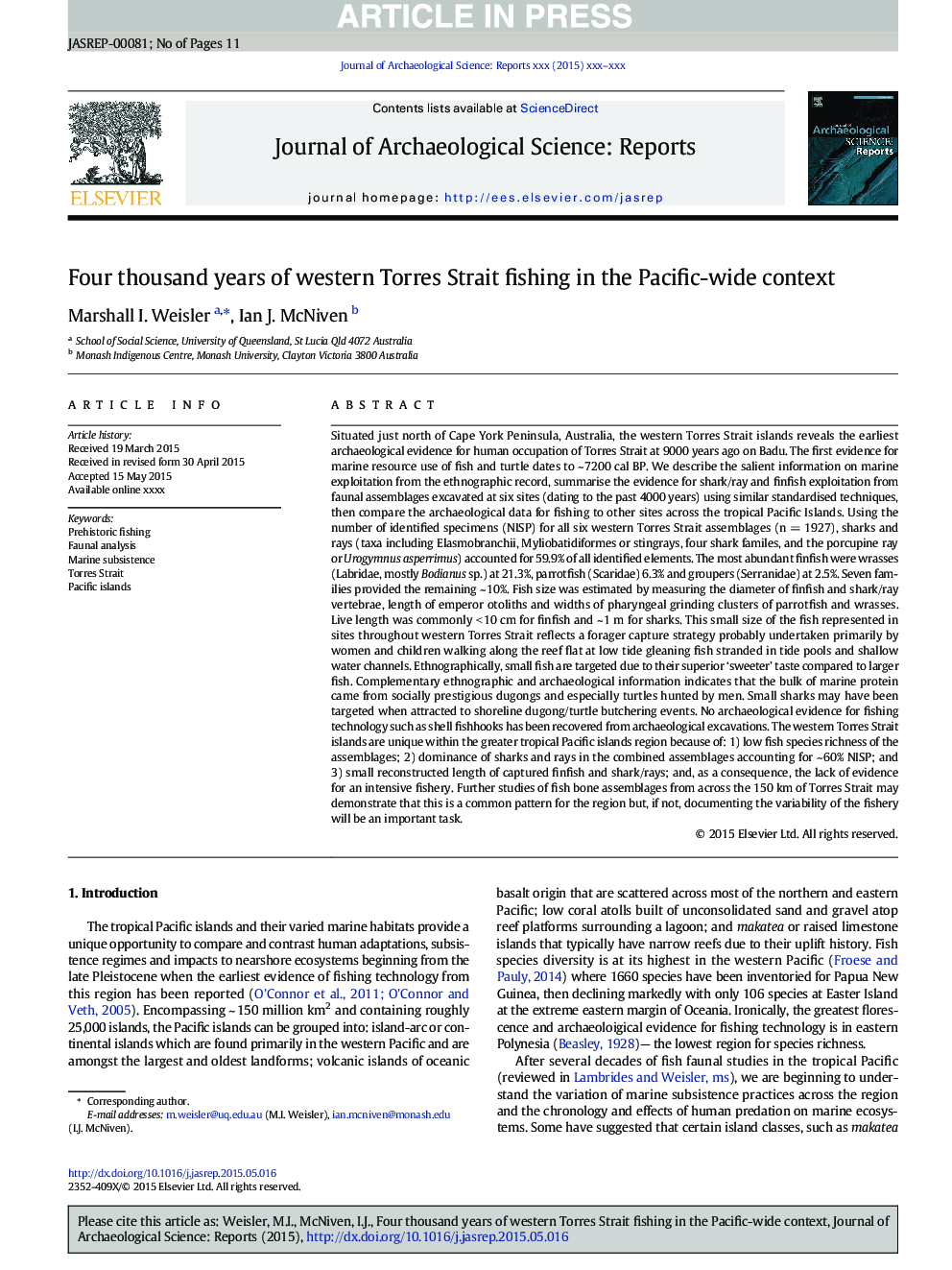| کد مقاله | کد نشریه | سال انتشار | مقاله انگلیسی | نسخه تمام متن |
|---|---|---|---|---|
| 10499968 | 944184 | 2016 | 11 صفحه PDF | دانلود رایگان |
عنوان انگلیسی مقاله ISI
Four thousand years of western Torres Strait fishing in the Pacific-wide context
ترجمه فارسی عنوان
چهار هزار ساله ماهیگیری غربی تورس در منطقه اقیانوس آرام
دانلود مقاله + سفارش ترجمه
دانلود مقاله ISI انگلیسی
رایگان برای ایرانیان
کلمات کلیدی
ماهیگیری ماقبل تاریخ، تجزیه و تحلیل فون، معیشت دریایی، تورس تنگه، جزایر اقیانوس آرام،
موضوعات مرتبط
علوم انسانی و اجتماعی
علوم انسانی و هنر
تاریخ
چکیده انگلیسی
Situated just north of Cape York Peninsula, Australia, the western Torres Strait islands reveals the earliest archaeological evidence for human occupation of Torres Strait at 9000 years ago on Badu. The first evidence for marine resource use of fish and turtle dates to ~ 7200 cal BP. We describe the salient information on marine exploitation from the ethnographic record, summarise the evidence for shark/ray and finfish exploitation from faunal assemblages excavated at six sites (dating to the past 4000 years) using similar standardised techniques, then compare the archaeological data for fishing to other sites across the tropical Pacific Islands. Using the number of identified specimens (NISP) for all six western Torres Strait assemblages (n = 1927), sharks and rays (taxa including Elasmobranchii, Myliobatidiformes or stingrays, four shark familes, and the porcupine ray or Urogymnus asperrimus) accounted for 59.9% of all identified elements. The most abundant finfish were wrasses (Labridae, mostly Bodianus sp.) at 21.3%, parrotfish (Scaridae) 6.3% and groupers (Serranidae) at 2.5%. Seven families provided the remaining ~ 10%. Fish size was estimated by measuring the diameter of finfish and shark/ray vertebrae, length of emperor otoliths and widths of pharyngeal grinding clusters of parrotfish and wrasses. Live length was commonly < 10 cm for finfish and ~ 1 m for sharks. This small size of the fish represented in sites throughout western Torres Strait reflects a forager capture strategy probably undertaken primarily by women and children walking along the reef flat at low tide gleaning fish stranded in tide pools and shallow water channels. Ethnographically, small fish are targeted due to their superior 'sweeter' taste compared to larger fish. Complementary ethnographic and archaeological information indicates that the bulk of marine protein came from socially prestigious dugongs and especially turtles hunted by men. Small sharks may have been targeted when attracted to shoreline dugong/turtle butchering events. No archaeological evidence for fishing technology such as shell fishhooks has been recovered from archaeological excavations. The western Torres Strait islands are unique within the greater tropical Pacific islands region because of: 1) low fish species richness of the assemblages; 2) dominance of sharks and rays in the combined assemblages accounting for ~ 60% NISP; and 3) small reconstructed length of captured finfish and shark/rays; and, as a consequence, the lack of evidence for an intensive fishery. Further studies of fish bone assemblages from across the 150 km of Torres Strait may demonstrate that this is a common pattern for the region but, if not, documenting the variability of the fishery will be an important task.
ناشر
Database: Elsevier - ScienceDirect (ساینس دایرکت)
Journal: Journal of Archaeological Science: Reports - Volume 7, June 2016, Pages 764-774
Journal: Journal of Archaeological Science: Reports - Volume 7, June 2016, Pages 764-774
نویسندگان
Marshall I. Weisler, Ian J. McNiven,
